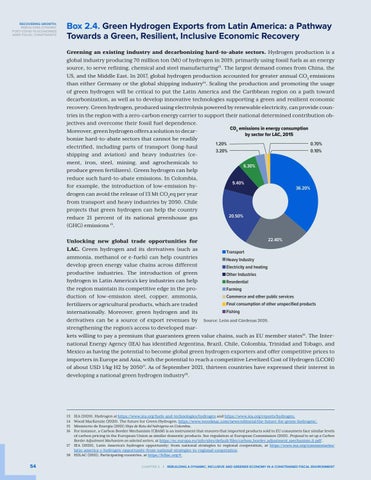RECOVERING GROWTH: REBUILDING DYNAMIC POST-COVID-19 ECONOMIES AMID FISCAL CONSTRAINTS
Box 2.4. Green Hydrogen Exports from Latin America: a Pathway Towards a Green, Resilient, Inclusive Economic Recovery Greening an existing industry and decarbonizing hard-to-abate sectors. Hydrogen production is a global industry producing 70 million ton (Mt) of hydrogen in 2019, primarily using fossil fuels as an energy source, to serve refining, chemical and steel manufacturing13. The largest demand comes from China, the US, and the Middle East. In 2017, global hydrogen production accounted for greater annual CO2 emissions than either Germany or the global shipping industry14. Scaling the production and promoting the usage of green hydrogen will be critical to put the Latin America and the Caribbean region on a path toward decarbonization, as well as to develop innovative technologies supporting a green and resilient economic recovery. Green hydrogen, produced using electrolysis powered by renewable electricity, can provide countries in the region with a zero-carbon energy carrier to support their national determined contribution objectives and overcome their fossil fuel dependence. CO2 emissions in energy consumption Moreover, green hydrogen offers a solution to decarby sector for LAC, 2015 bonize hard-to-abate sectors that cannot be readily 1.20% 0.70% electrified, including parts of transport (long-haul 3.20% 0.10% shipping and aviation) and heavy industries (cement, iron, steel, mining, and agrochemicals to 6.30% produce green fertilizers). Green hydrogen can help reduce such hard-to-abate emissions. In Colombia, 9.40% for example, the introduction of low-emission hy36.20% drogen can avoid the release of 13 Mt CO2eq per year from transport and heavy industries by 2050. Chile projects that green hydrogen can help the country 20.50% reduce 21 percent of its national greenhouse gas 15 (GHG) emissions . 22.40% Unlocking new global trade opportunities for LAC. Green hydrogen and its derivatives (such as Transport ammonia, methanol or e-fuels) can help countries Heavy Industry develop green energy value chains across different Electricity and heating productive industries. The introduction of green Other Industries hydrogen in Latin America’s key industries can help Resedential the region maintain its competitive edge in the proFarming Commerce and other public services duction of low-emission steel, copper, ammonia, Final consumption of other unspecified products fertilizers or agricultural products, which are traded Fishing internationally. Moreover, green hydrogen and its derivatives can be a source of export revenues by Source: León and Cárdenas 2020. strengthening the region’s access to developed markets willing to pay a premium that guarantees green value chains, such as EU member states16. The International Energy Agency (IEA) has identified Argentina, Brazil, Chile, Colombia, Trinidad and Tobago, and Mexico as having the potential to become global green hydrogen exporters and offer competitive prices to importers in Europe and Asia, with the potential to reach a competitive Levelized Cost of Hydrogen (LCOH) of about USD 1/kg H2 by 205017. As of September 2021, thirteen countries have expressed their interest in developing a national green hydrogen industry18.
13 14 15 16
IEA (2020), Hydrogen at https://www.iea.org/fuels-and-technologies/hydrogen and https://www.iea.org/reports/hydrogen. Wood MacKenzie (2020). The future for Green Hydrogen. https://www.woodmac.com/news/editorial/the-future-for-green-hydrogen/. Ministerio de Energia (2021) Hoja de Ruta del hidrógeno en Colombia. For instance, a Carbon Border Mechanism (CBAM) is an instrument that ensures that imported products sold to EU consumers face similar levels of carbon pricing in the European Union as similar domestic products. See regulation at European Commission (2021). Proposal to set up a Carbon Border Adjustment Mechanism on selected sectors, at https://ec.europa.eu/info/sites/default/files/carbon_border_adjustment_mechanism_0.pdf . 17 IEA (2020), Latin America’s hydrogen opportunity: from national strategies to regional cooperation, at https://www.iea.org/commentaries/ latin-america-s-hydrogen-opportunity-from-national-strategies-to-regional-cooperation. 18 H2LAC (2021), Participating countries, at https://h2lac.org/#.
54
CHAPTER 2 | Rebuilding a Dynamic, Inclusive and Greener Economy in a Constrained Fiscal Environment


